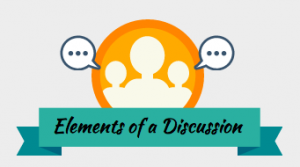Facilitating discussions
Role and qualities of effective facilitators
A facilitator should:
- Draw out knowledge and insight from group members
- Recognize each individual and their right to be heard and ensure everyone has a change to have their ideas expressed
- Acknowledge each person’s perspectives
- Provide feedback that focuses on observations rather than judgements
- Use different skills, tools, exercises and natural abilities to keep a group discussion moving smoothly and in a direction that addresses the question or topic
- Maintain a safe and respectful group environment
- Be genuine in contributing to the discussion
- Be aware of their own values, thoughts and unresolved issues, and recognize the impact these have on others

1. Planning the Discussion
Consider the participants in determining the appropriate level and approach:
- Demographics – What are their ages and genders? What are their cultural, academic, and educational backgrounds?
- Interests – Why are they there? Is this discussion of short-term or long-term interest to them?
- Analysis – Who are they? How many will be there (this is important information if you are going to break them into groups)?
- Environment – How will I set up the room? Will I bring props or visuals to the discussion?
- Find out what the participants already know (Pre-assessment) “what do the learners already know about this topic?” – this will allow you to choose appropriate elements for your discussion.
Structuring groupings:
 Whole group discussions can inhibit participation from some group members and it may be more effective to divide the large group into smaller ones. Some examples of groupings are:
Whole group discussions can inhibit participation from some group members and it may be more effective to divide the large group into smaller ones. Some examples of groupings are:
- Think pair share – Participants respond to a question as individuals, then they pair up and discuss their responses.
- Buzz groups – Participants gather in groups of four or five to discuss issues. This can allow the group members to discuss issues freely. It can be structured with groups having to answer a series of questions with one member reporting their answers to the large group.
- Jigsaw – One participant from each group individually becomes an “expert” on one aspect of a topic. Then each expert reports back to their original group and brings their expertise to the discussion of the set topic.
- Critical debate – Learners are asked to explore an idea or take a position that they find unfamiliar, unsympathetic, or even objectionable. They do this as members of a debate team. Participants are asked to make the strongest possible case for a position that is diametrically opposed to their own.
Roles within a group:

- Discussion leader or facilitator – Introduces the topic or question, outlines the expected outcomes and asks questions to guide the discussion.
- Designated listener – These participants do not contribute ideas of their own, but listen intently, ask the occasional questions, to check for understanding or clarification. At the end of the discussion, t hey are expected to summarize the main ideas expressed.
- Note taker: This can be done by the designated listener. At the end of the discussion they relate the points back to the topic or question.
2. Introducing the discussion
- It is important that you engage participants so that they are fully present throughout the discussion.
- Begin the discussion with a short introduction (a “bridge” or a “hook”) which is intended to grab the listeners’ attention and motivate them to be involved.
- Use a personal story, a news article or the goals of the course to initiate interest in the issue or question for discussion.
- Also explaining how participation in the discussion will benefit them can be a useful motivator. Review the learning outcomes (see below) so students know what is expected of them.
 Use learning outcomes: These identify the intended outcomes of the activity and are usually framed as a statement indicating what students will be able to do by the end of the activity. Learning outcomes are:
Use learning outcomes: These identify the intended outcomes of the activity and are usually framed as a statement indicating what students will be able to do by the end of the activity. Learning outcomes are:
- Observable or action oriented: Concerned with participant performance (learner centered), not the objectives of the teachers or facilitators.
- Specific: Measurable, rather than broad and intangible.
- Phrased “Participants (students if applicable) will be able to…”.
- Describe what the learner is expected to be able to do (for example: label, define, integrate), to what level (for example: identify all, distinguish between two) and with what resources (for example: using lecture notes and the readings, drawing on personal experience).
- A separate statement should be provided for each important outcome or intent.
- Indicate how the learner will be evaluated and how assessments align with each outcome.
- Given to the participants and made clear what is required of them.
Benefits of using learning outcomes:
- Learners can take responsibility for an activity and for staying on topic.
- They can help focus the selection of content, resources and materials.
- They allow you and the participants to determine if learning has been accomplished.
3. Use questions to maintain discussion
 Questions can be used in keeping the discussion on track or prompting related ideas.
Questions can be used in keeping the discussion on track or prompting related ideas.
- Questions that ask for more evidence: The question should be asked as a simple request for more information, not as a challenge to the speaker’s intelligence.
- Questions that ask for clarifications: It is important that speakers are understood by the rest of the group. These questions should be an invitation to convey one’s meaning to the as clearly as possible.
- Open questions: These are more likely to provoke participants’ thinking and problem-solving abilities and make the fullest use of discussion potential for expanding intellectual and emotional horizons.
- Linking or extension questions: These questions tend to prompt participant -to- participant conversation.
- Hypothetical questions: These questions ask participants to consider how changing the circumstances of a case might alter the outcome. They require participants to draw on their knowledge and experience to conjure up plausible scenarios. Usually responses are highly creative and can take a group that is reluctant to take risks to a new level of engagement and understanding.
- Cause-and-effect questions: These questions ask participants to consider relationships between idea/events/scenarios and are fundamental to promoting critical thought.
- Summary and synthesis questions: These questions call on participants to identify important ideas and think about them in ways that will aid recall.
4. Concluding the discussion
A discussion often takes group members in many different directions, exploring concepts, and perspectives. It is essential that participants leave with a sense of accomplishment and closure.
- Return to learning outcomes: At the end of the discussion, have participants evaluate whether they have accomplished the learning outcomes.
- Drawing conclusions: Each group provides the major points or ideas that were brought up through the course of the discussion.
- These activities summarise the learning that has occurred and are extremely useful in determining if the learning outcomes were achieved through the discussion.
Emergency procedures
UBC employees should be aware of the emergency procedures and protocols in order to become better prepared to handle emergencies, accidents, disasters or injuries, as these may occur at any time. To familiarize yourself with emergency procedures, click here.